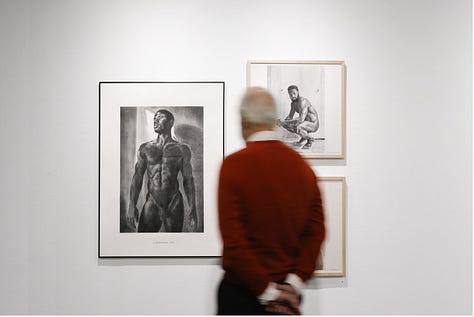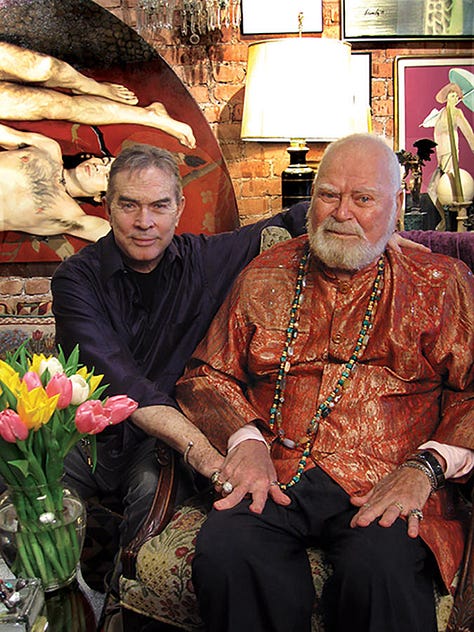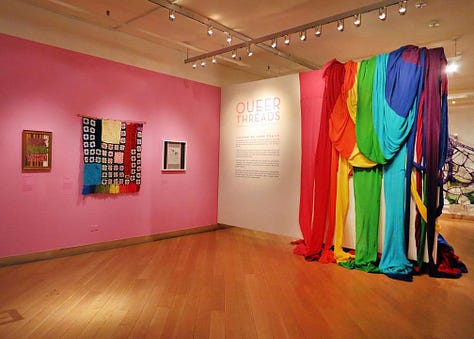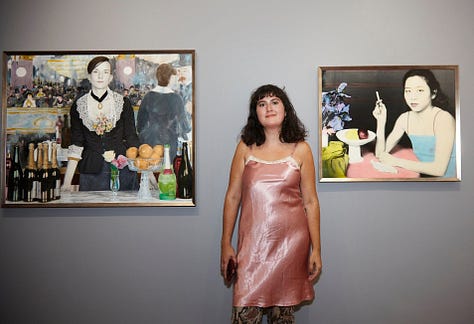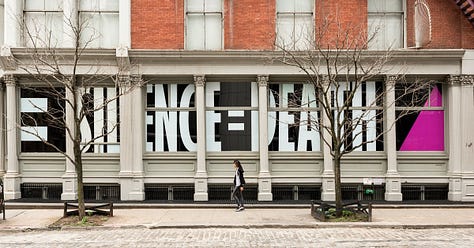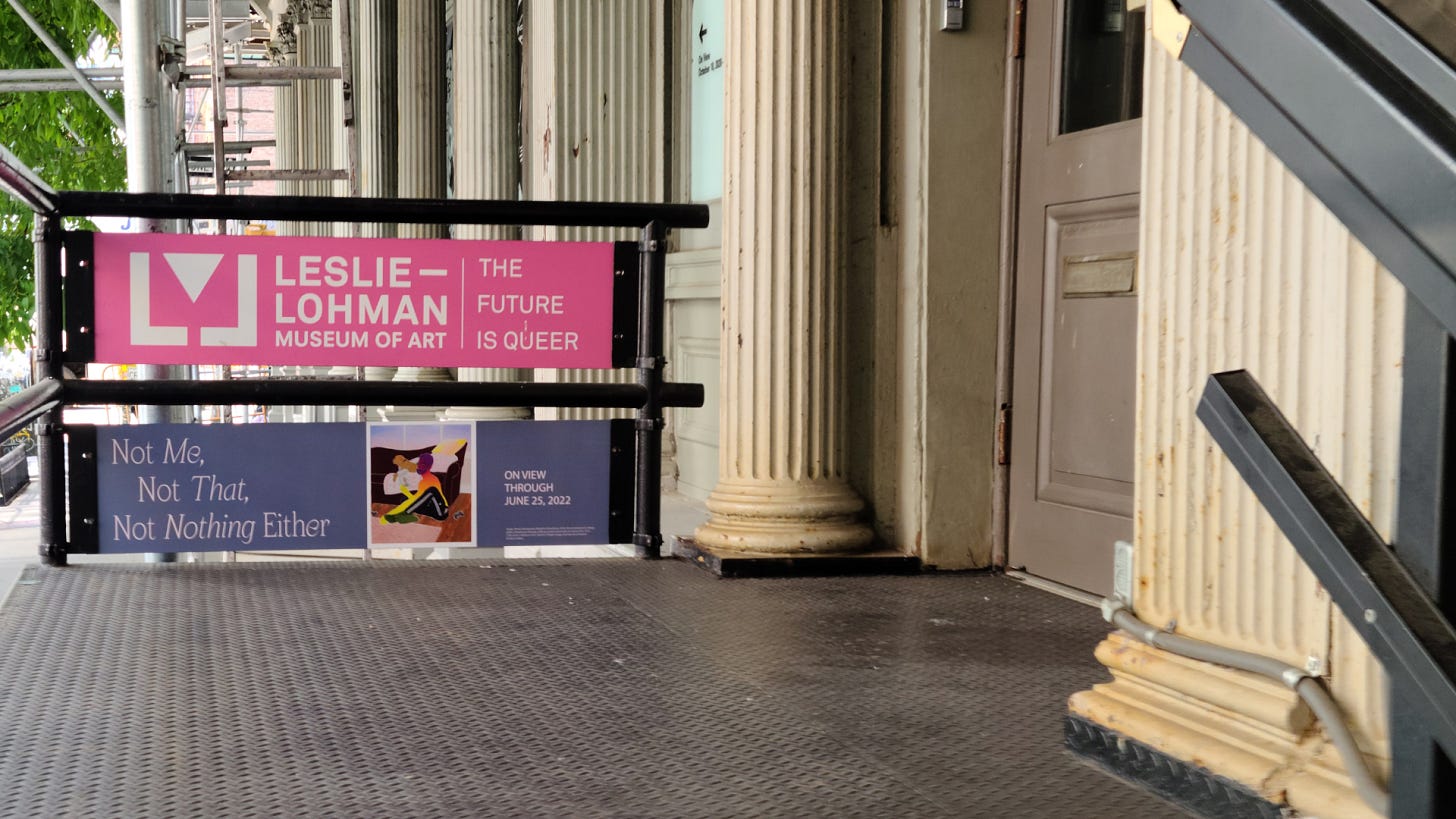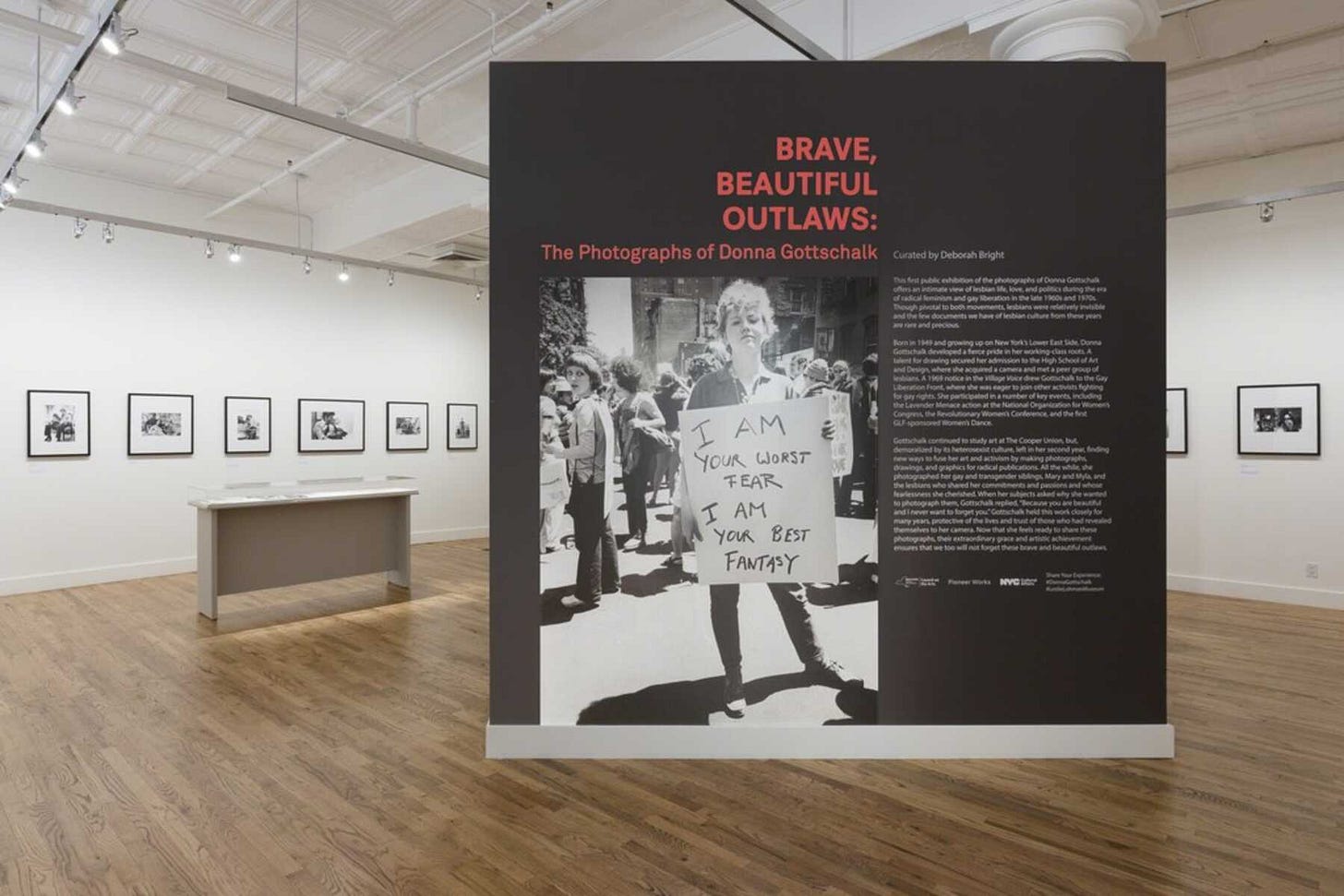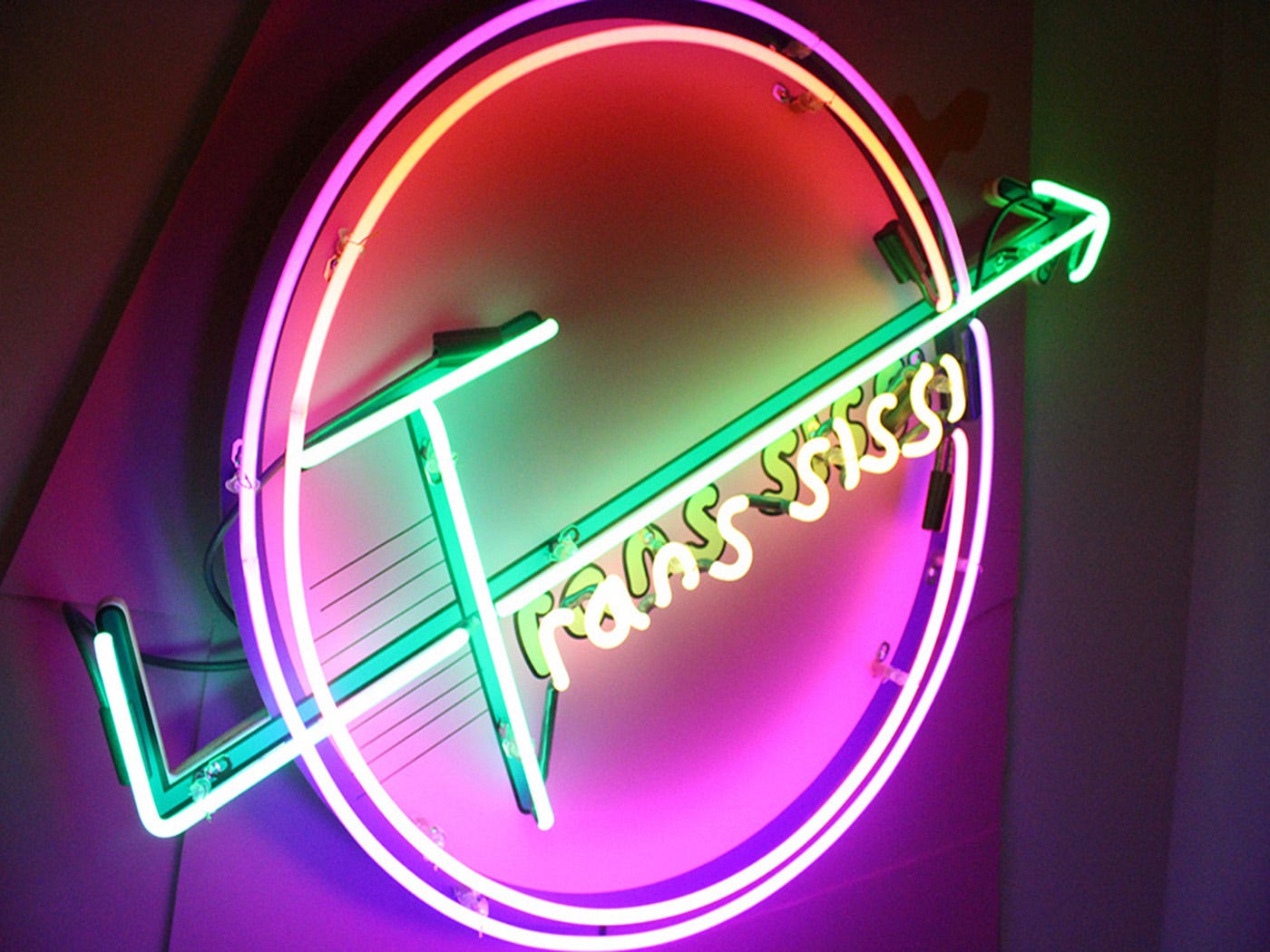Leslie & Lohman's Legacy: The Birth of NYC's LGBTQ Art Museum
How two men went from collecting art for their home to establishing one of the world's premier queer art institutions
New York City is proudly home to the Leslie-Lohman Museum of Art (LLMA), located at 26 Wooster Street in Lower Manhattan, which as of 2023, is somehow still the only museum in the world exclusively dedicated to showcasing LGBTQ artwork. While there certainly are other LGBTQ-related museums across the globe, Leslie-Lohman is truly the only permanent, queer art-specific museum in existence that is not solely dedicated to a single artist (So, for example, the Andy Warhol Museum in Pittsburgh is certainly a queer art museum, but it’s mostly about Andy). As of 2023, the Leslie-Lohman Museum counts over 25,000 queer art objects in its holdings, and maintains a busy, year-round calendar of exhibitions, public programs and publications. Like any established queer institution, however, the Leslie-Lohman Museum had humble, grass-roots beginnings, which trace back to the year 1969, when two gay men decided to hold a small little exhibit of gay art in their SoHo loft residence.
The Leslie-Lohman Museum’s history begins with partners Charles W. Leslie (b. 1933) and J. Frederic "Fritz" Lohman (1922-2009), which is, of course, from where the museum derives its name. Leslie was born and raised in Deadwood, South Dakota and attended the Pasadena Playhouse College of Theatre Arts. During the Korean War, he was stationed in Heidelberg, Germany, where he first encountered the works of German sexologist Magnus Hirschfeld. After he was released from duty, Leslie toured Europe with the Lotte Goslar Pantomime Circus for several years and during his time in Europe, started to realize there was such a thing as “gay history”, but that much of that history was only preserved in art. He soon began to secretly buy any such work he could lay his hands on. “I’d go to a flea market and find some little drawing or something that gave me a certain frisson,” he informed queer historian Hugh Ryan in a 2015 Smithsonian Magazine article, “if I could afford it, I'd buy it.”
Leslie later enrolled in the Sorbonne in Paris, but eventually returned to the United States, joining the touring production of Tennessee Williams’s play, Suddenly Last Summer, while settling to live in SoHo, which at the was “an industrial slum”. In 1962, Leslie met Fritz Lohman at brunch with friends. Lohman, who was older, was born in Fort Wayne, Indiana, and was already running a successful interior design business which catered to a wealthy clientele, including Barbara Walters, the Onassis family, and the late French fashion designer Jacques Fath. The two hit it off, and became lovers. “We made the discovery early on that we'd both been discreet collectors of gay imagery,” Leslie told Ryan. The pair combined their resources, connections and mutual interests and commenced with amassing a trove of gay art.
By 1969, Leslie and Lohman were living together in a loft at 131 Prince Street, and the pair played a pivotal role in having the neighborhood be rezoned be from commercial to residential, which helped forge the landscape of the neighborhood that we call SoHo today. They were also instrumental in preserving the region’s historic cast-iron buildings, which resulted in the designation of the SoHo-Cast Iron Historic District by the NYC Landmarks Preservation Commission in 1973. In 1969, Leslie and Lohman also made another watershed move, when they decided to start showing off some of their collection. In May of that year, they held their first homoerotic art show in their SoHo loft, which shortly thereafter came to be called the "Phallus Palace".
The gay-themed works on display in this first exhibit were (in addition to being mostly cis/gay/male/white) primarily ones that most art galleries at the time deemed too explicit and controversial. The turnout, however, far exceeded both Leslie and Lohman’s expectations, with hundreds of people showing up to ogle their homoerotic collection. "When we first set up house, we became aware that many great artists were gay," Leslie told Ula Ulnytzky of The Star Democrat in 2010, “we noticed that a lot of them had amazing works of erotica and political and social imagery that resonated with the gay community.” The successful turnout in their home encouraged the couple to hold more showings, which they continued to do until 1972, when they pair were finally inspired to open what would become the first official Leslie-Lohman Gallery at 485 Broome Street. “Finally, this art could come out of the closet,” Leslie told Julia Fiore in Artsy.
On Broome Street, Leslie-Lohman continued to showcase predominantly white, gay male, homoerotic art (including an early show introducing Tom of Finland to NYC) but also began to branch out to include work by women, such as Marion Pinto’s solo exhibit “Man as a Sex Object”, as well as less overtly erotic work. For nearly a decade, the Broome Street gallery remained open but struggled to survive, operating on a thin profit margin and enduring frequent visits from the cops who would try to convince Leslie to stop displaying such overtly gay art.
Ultimately, the Broome Street location hung on as a labor of love until 1981, when the AIDS crisis would begin to eat away at both the Gallery’s customer base and artist networks. “Within two years we lost 14 good friends,” Leslie told Ryan, “two of them died in our house because they had no place to go.” While the devastation of AIDS and the 1980s forced Leslie and Lohman to shutter their Broome Street gallery, it also fueled their collecting habits further—as they witnessed many gay artists and collectors dying and realized that many important works of art would be be destroyed by their families, who would not know what to make of this type of outré art or who would refuse to acknowledge their relatives’ sexuality altogether.
Spurred by this urgency, in 1987 Leslie and Lohman co-founded a non-profit organization called The Leslie-Lohman Gay Art Foundation. In applying for nonprofit status as a precursor to establishing the foundation, Leslie and Lohman encountered some pushback: The IRS, at the time, objected to their having the word "gay" in the foundation’s title, and held up the nonprofit application for several years, only granting it official nonprofit status in 1990. While waiting, Leslie and Lohman opened up a new Leslie-Lohman Gallery in 1987, in the basement space at 127B Prince Street. It would, appropriately, be referred to as "The Basement" and would serve as Leslie-Lohman’s primary location for almost twenty years.
The year 2006 saw the move of the Leslie-Lohman Gallery above ground, to its current location at 26 Wooster Street. In 2010, Fritz Lohman passed away at the age of 87, leaving the younger Leslie on his own to continue overseeing their vast collection. In 2011, the foundation was officially awarded museum status by the New York State Board of Regents, and was formally accredited as a museum in 2016. It was then renamed the Leslie-Lohman Museum of Gay and Lesbian Art. Meanwhile, the 127B Prince Street location reopened as the Leslie-Lohman Prince Street Project Space, (now just called the SoHo Project Space), which continues to function as a rotating performance and exhibition space that supports living artists with pop-up shows.
Over the years, the Prince Street Project Space has continued to hold countless notable LGBTQ exhibitions, such as Frank Melleno's "Fairoaks Baths", Enrico Richard Gomez's "Sacred Passages", Brent Ray Fraser's "Nudus Erectus", Hans Fahrmeyer's "Masculine Reflections", Eva Mueller's "Flowers & Chocolate", Kim Hanson's "Men and Memorabilia" and "Steven Menendez's "Earth Worship". It has also held many collective exhibits, such as "Boys Of Summer"—artwork from the Pines Nude Drawing Group, and "It’s a Queer, Queer, Queer World: Works by LGBTQ+ Artists".
The Leslie-Lohman Museum itself, meanwhile, has continued to both grow and diversify over the years. From 2016 to 2017, the Wooster Street space underwent renovations and an expansion. In 2019, in an effort to shift towards becoming an even more inclusive space, the Museum changed its name from The Leslie-Lohman Museum of Gay and Lesbian Art to just the Leslie-Lohman Museum of Art and began marketing itself with taglines such as “The Future Is Queer”. At that time, the Museum’s executive director, Gonzalo Casals, told ARTnews that the rebranding was emblematic of “what the vision of the future of the museum is”, and that it was important to ensure that “the past is informing the present, so we can be projected into the future. Part of that was embracing the idea of queerness in the most expansive way possible. In doing that it became evident that our name needed to be as expansive as the concept of queerness, so that everyone feels welcome to the museum.”
Since then, The Leslie-Lohman Museum has diligently been working to diversify its collection to include more work from queer, trans, nonbinary, and BIPOC artists as well to showcase a variety of diverse art in its exhibitions and programs. Recent stellar exhibitions there have included “INDECENCIA” (2022-2023), showcasing work from a cohort of queer artists from Latin America and/or of Latin American descent, “On Our Backs” (2020), displaying a collection of art which explores the history of queer sex work culture, and “Brave, Beautiful Outlaws” (2019), an exhibition devoted to the work of radical lesbian activist and photographer Donna Gottschalk, among others.
The Leslie-Lohman museum also continues to maintain and add to its ever-growing permanent collection, into which more than 1,300 objects have been accessioned. The collection contains works by a number of well-known LGBTQ+ artists including Berenice Abbott, Abel Azcona, David Hockney, Ingo Swann, Catherine Opie, Andy Warhol, Tom of Finland, Delmas Howe, Jean Cocteau, David Wojnarowicz, Robert Mapplethorpe, George Platt Lynes, Duncan Grant, James Bidgood, Peter Hujar and many more.
On an annual basis, the Leslie-Lohman museum puts up between 6 to 8 exhibitions at 26 Wooster Street, 4 to 6 exhibitions in its Wooster Street Window Gallery, and multiple weekend exhibitions and drawing workshops at its Prince Street Space. Exhibitions are typically organized by guest curators who submit proposals that are reviewed by the museum director and exhibition committee. Additionally, the museum offers a complete year-round schedule of educational programing, including talks and lectures from the likes of Slava Mogutin, Duane Michals, Catherine Opie and Jonathan David Katz, as well as film screenings, book signings, and other miscellaneous events.
If you have yet to visit the Leslie-Lohman Museum, be sure to get there before January 7th to catch their current exhibit, “Dreaming of Home” which, curated by Gemma Rolls-Bentley, explores the comforts and complications of queer domestic life across international and intergenerational perspectives. Rolls-Bentley hopes that the exhibition can offer both a sense of homecoming and belonging to those within the community, as well as a point of compassion and education for those who are not. “I really believe in the power of art to make people have empathy and to see other people’s perspectives,” she told AnOther Magazine, “…I hope this show will help people get some insight into alternative perspectives. Somebody described it as a queer spiritual homecoming, and I thought that was beautiful.”
Besides, it’s totally worth a visit just to say you’ve spent time in one of the oldest institutions engaged in the preservation of queer art!


